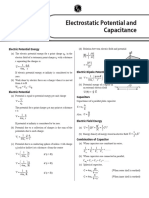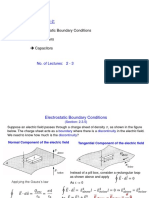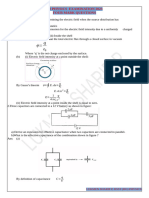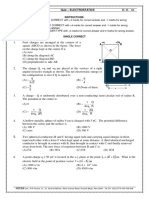The Equivalent Capacitance Between Points A and B Is
The Equivalent Capacitance Between Points A and B Is
Uploaded by
gwgkvks2d2Copyright:
Available Formats
The Equivalent Capacitance Between Points A and B Is
The Equivalent Capacitance Between Points A and B Is
Uploaded by
gwgkvks2d2Original Title
Copyright
Available Formats
Share this document
Did you find this document useful?
Is this content inappropriate?
Copyright:
Available Formats
The Equivalent Capacitance Between Points A and B Is
The Equivalent Capacitance Between Points A and B Is
Uploaded by
gwgkvks2d2Copyright:
Available Formats
Gamma Question Bank for Engineering Physics > Chapter 16
- Electrostatic Potential and Capacitance > EXERCISE
2.6 > Q 66
EASY JEE Main/Advance
Earn 100
IMPORTANT
The equivalent capacitance between points A
and B is
3C
(a) 4
C
(b) 3
3C
(c) 2
(d) None of these
50% students
Check
answered this correctly
Solution Hint Solve with us
In given figure equipotential point are shown in by
1& 2
Here C1 = C2 = C3 = C4 = C5 = C6 = C
Here C1 , C2 & C3 are connected between point
1&2
and C4 & C5 are bypassed due to same potential
point 2
So equivalent circuit is
All
capacitor between points 1 and 2 in parallel
combination. So, equivalent of them are
Ceq = C1 + C2 + C3
⇒ Ceq = C + C + C = 3C
1 1 1 1 1
C net
= C1
+ C2
= 3C
+ C
3C
⇒ C net = 4
JEEMAINIADVANCE ADAPTIVELY
LEARNWITHSOLUTIONS PRACTICEQUESTIONS
GAMMAQUESTIONBANK
FORENGINEERING NOPUBLICATIONPHYSICSJEE
PHYSICS MAIN/ADVANCE
EmbibeExperts
Important Questions on Electrostatic Potential and
Capacitance
EASY JEE Main/Advance IMPORTANT
Gamma Question Bank for Engineering
Physics > Chapter 16 - Electrostatic Potential and
Capacitance > EXERCISE 2.6 > Q 67
Initial charges on both the capacitors are C V . Find
change in potential energy of both if a battery is
connected as shown. Also find the work done by
battery.
Xin=CV
gin=CV
Initially
(t=0)
EASY JEE Main/Advance IMPORTANT
Gamma Question Bank for Engineering
Physics > Chapter 16 - Electrostatic Potential
and Capacitance > EXERCISE 2.7 > Q 68
The capacitance of a parallel plate capacitor
when a very thin metallic sheet is placed in the
space between the plates, parallel to the
plates, will
EASY JEE Main/Advance IMPORTANT
Gamma Question Bank for Engineering
Physics > Chapter 16 - Electrostatic Potential
and Capacitance > EXERCISE 2.7 > Q 69
A thin metallic strip is introduced between the
plates of a parallel plate capacitor, touching
the plates. How will capacitance change?
View More
Important Points to Remember in Chapter 16 -
Electrostatic Potential and Capacitance from
Embibe Experts Gamma Question Bank for
Engineering Physics Solutions
24. Electric Potential:
The amount of work done to move a unit positive
charge from infinity to a certain point against the
electric field.
W ext
(i) V = q0
(ii) Electric potential is a scalar.
(iii) S.I. unit: J C−1 .
(iv) Dimension: ML2 T−3 A−1 .
(v) Positive charge gives positive potential and
negative charge produces a negative potential.
25. Electric Potential Due to a Point Charge:
Electric potential due to a point charge q at a distance
q
r is V = 4π1ε r . 0
26. Electric Potential Di!erence:
The amount of work done to move a unit positive
charge from one point to another against the electric
field.
W ext W A→B(ext)
∆V = q0 (or) VB − VA = q0
27. Consider two points A and B at distances r 1 and
r2 (r1 < r2 ) from a point charge q, then
( r11 − )
q 1
(i) V A − V B = 4πε 0 r2
(ii) Potential decreases, if we move away from positive
charge, i.e., V B − V A is − ve, if q is + ve.
(iii) Potential increases, if we move away from a
negative charge, i.e., V B − V A is + ve, if q is – ve.
(iv) Work done to move a charge q 0 from B to A is,
( r11 − )
qq 0 1
Wext = q0 (VA − VB ) = 4πε 0 r2
(v) Welectric = −Wext
28. Electric Potential Due to a System of Charges:
The potential at a point is equal to the scalar sum of
potential due to individual charges.
( r11 + )
1 q q2 qn
Potential at P is V = 4πε 0 r2 +⋯+ rn
29. Potential Due to Infinite Charges on x-Axis:
(i) When identical like charges are placed as shown,
then the potential at origin is
1 1 1 1 q
V = 4πε 0
[1 + 2
+ 4
+ 8
+ ⋯] = 2πε 0
(ii) If the alternative charges are opposite, then
q
V = 6πε 0
30. Potential Due to a Uniformly Charged Ring:
q
(i) At the centre of the ring, V centre = 4πε R = 2ελ ,
0 0
where q is charge on the ring, R is radius and λ is linear
charge density.
(ii) Potential at a point on the axis:
Q λR
Vaxis = 4πε 0 √ R 2 +x 2
= 2ε 0 √ R 2 +x 2
31. Electric Potential Due to a Charged Rod:
(i) On axis:
Q
V = 4πε 0 l ln(1 + rl ) = λ
4πε 0 ln( r+l
r )
(ii) On perpendicular bisector:
( 2l )+√ ( 2l ) +x 2
]
2
Q
V = 4πε 0 l ln[
(− 2l )+√ ( l ) +x 2
2
2
32. Electric Potential Due to a Uniformly Charged Disc
on Its Axis:
(i) V = σ
2ε 0 [√R2 + x2 − x]
σR
(ii) If R ≫ x, then V = 2ε 0 considering potential at ∞
as zero.
33. Potential Due to Infinite Line Charge:
∣
r→ r
(i) V =
W ext →
= − ∫ E ⋅ dr = − ∫ λ
q0 2πε 0 r dr (not defined)
∞ ∞
potential at a point due to infinite line charge cannot
be determined, but potential di!erence can be
calculated.
(ii) ∆V = V A − V B = λ
2πε 0 ln( rr21 )
34. Electric Potential on the Edge of a Uniformly
Charged Disc:
σR
V = 2ε 0
35. Electric Potential at Centre of a Uniformly Charged
Hemispherical Shell:
σR
Vcenter = 2ε 0
36. Electric Potential Due to a Uniformly Charged Non-
conducting Sphere:
(i) Potential outside the sphere,
Q ρR 3
Vout = 4πε 0 x (x > R) or Vout = 3ε 0 x
(ii) Potential on the surface of sphere,
Q ρR 2
Vsur = 4πε 0 R or V sur = 3ε 0
(iii) Potential inside the sphere is
ρ
Vinside = 3ε0 [1.5R2 − 0.5r2 ], where R = radius
distance and ρ = volume charge density.
3
(iv) Potential at the centre is V centre = 2 Vsurf ace .
37. Potential Due to a Uniformly Charged Spherical
Shell (or) Conducting Sphere:
(i) Potential inside the shell is equal to potential on the
surface,
1 Q σR
Vinside = Vsur = 4πε 0 R
= ε0
(ii) Potential outside the shell,
Q σR 2
Vout = 4πε 0 x ε 0 x (x > R)
38. Potential Di!erence Between Two Concentric
Shells:
Consider two shells of radial r 1 and r 2 (> r 1 ) are
concentric and have charges q 1 and q 2 . Then,
q1 q2
(i) Potential of shell A is V A = 4πε 0 r 1 + 4πε 0 r 2 .
q 1 +q 2
(ii) Potential of shell B is V B = 4πε 0 r 2 .
( r12 − )
q1 1
(iii) V B − V A = 4πε 0 r1
(a) If q 1 is + ve, then V B − V A is − ve (or) V A > V B .
(b) If q 1 is − ve, then V A < V B .
(c) Potential di!erence between the shells is
independent of charge of the outer shell.
(d) If the two shells are connected by a conducting
inner to outer shell. This is the principle of Van de Gra!
generator.
39. Potential Due to Three Concentric Shells:
The figure shows three conducting concentric shell of
radii a, b and c (a < b < c) having charges Qa , Qb
and Qc , respectively.
[ ].
1 Qa Qb Qc
(i) Potential at A is V A = 4πε 0 a + b + c
[ ].
1 Qa Qb Qc
(ii) Potential at B is V B = 4πε 0 b + b + c
[ ].
1 Qa Qb Qc
(iii) Potential at C is V C = 4πε 0 c + c + c
40. Earthing of Shell:
The figure shows two concentric spheres having radii r 1
and r 2 , respectively, (r 2 > r 1 ). Charge on the inner
sphere is +Q.
(i) When the outer sphere is earthed:
(a) Let Q′ be the charge on the outer surface, then
The potential at the surface of outer sphere,
1 Q 1 Q′
V2 = 4πε 0 r 2
+ 4πε 0 r 2
=0
⇒ Q′= −Q
(b) Potential of the inner sphere is
1 Q 1 (−Q)
[ r11 − ].
Q 1
V1 = 4πε 0 r 1
+ 4πε 0 r 2
= 4πε 0 r2
(ii) In the above case, if the outer sphere is given a
charge +Q and the inner sphere is earthed, then
(a) In this case, the potential at the surface of the inner
sphere is zero. So, if Q′ is the charge induced on
the inner sphere,
[ r1 + ] = 0 i.e., Q′= − rr12 Q
1 Q′ Q
then V 1 = 4πε 0 r2
(Charge on the inner sphere is less than that of the
outer sphere)
(b) Potential at the surface of outer sphere:
1 Q′ 1 Q
V2 = 4πε 0 r 2
+ 4πε 0 r 2
[−Q rr12 + Q] = [1 − ]
1 Q r1
⇒ V2 = 4πε 0 r 2 4πε 0 r 2 r2
41. Relation Between Electric Field and Potential
Di!erence:
(i) If dV is the potential di!erence between two points
separated by a distance dr in a uniform electric field on
a straight line parallel to the field, then
E = − dV
dr
.
(ii) In the above relation, negative sign indicates that
the potential decreases if we move in the direction of
the electric field.
(iii) Negative of the slope of the V − r graph denotes
the intensity of electric field, i.e., tanθ = dV
dr = −E
.
(iv) If the potential is a function of the coordinates
x, y, and z, then the electric field in space can be
→
written as E = Ex î + Ey ĵ + Ez k̂ , where Ex = − ∂∂Vx ,
Ey = − ∂∂Vy and Ez = − ∂∂Vz .
(v) If dV is the potential di!erence between two points
→
separated by dr in a uniform electric field on a straight
line making some angle to the field, then the electric
field can be determined by knowing the boundary
conditions,
r2 → →
dV = − ∫ r 1 E ⋅ dr
= − ∫rr12 Edrcosθ
(vi) If an electric field is given in space, then the
potential di!erence between two points in the space
can be calculated as,
→
∆V = VB − VA = − ∫rr12 E ⋅ d→ x y
r = − ∫x1 Ex dx − ∫y12 Ey dy
42. Equipotential Surface:
The locus of all points that are at the same potential is
called the equipotential surface.
Regarding equipotential surface, the following points
should be kept in mind:
(i) The direction of the electric field is perpendicular to
the equipotential surfaces or lines.
(ii) The equipotential surfaces produced by a point
charge or a spherically charge distribution are a family
of concentric spheres.
(iii) For a uniform electric field, the equipotential
surfaces are planes perpendicular to the field lines.
(iv) Equipotential surfaces due to electric dipole and
two identical charges separated are shown in the
below figure.
(v) A metallic surface of any shape is an equipotential
surface.
(vi) Equipotential surfaces can never cross each other.
(vii) The work done in moving a charge along an
equipotential surface is always zero.
43. Electric Dipole:
Two equal and opposite charges separated by a small
distance.
(i) Electric dipole moment (p):
→
The product of charge and length of the dipole.
→ →
(a) Dipole moment, p = q × 2l
(b) S.I. unit: C m
(c) Dimensions: LTA
(d) It is a vector quantity.
(e) Its direction is always from –q to +q.
(ii) Electric field on axial line:
→ 1 2pr
(a) Eaxial = 4π 0
ε (r 2 −l 2 ) r̂
(b) For a short dipole:
→ 1 2p
→
Eaxial = 4πε 0 r 3
(iii) Electric field on equatorial line:
→
→ (−P )
1
(a) Eequatorial = 4πε 0 (r 2 +l 2 ) 3/2
→ →
−p
(b) For short dipole, Eequatorial = 4πε 0 r 3 .
(iv) Electric field at the centre of dipole:
→ 1 2q 1
→
p
Emid = 4πε 0 l 2
= 4πε 0 l 3
(v) Electric field at any general point due to a short
dipole:
p
(a) E = 4πε 0 r 3
√1 + 3cos2 θ
(b) If ϕ is the angle made by the electric field with
position vector r, then tanϕ =
→ 1
2
tanθ.
(vi) Electric potential at midpoint of the dipole,
Vmid = 0.
kp
(vii) Potential on axial line, V axial = r 2 −l 2
.
1 P
For r ≫ l, V axial = 4πε 0 r 2
(viii) Potential at any point on an equatorial plane is
zero.
(ix) Potential at any general point due to dipole is,
1 pcosθ
Vgeneral = 4πε 0 r 2
44. Dipole in a Uniform Electric Field:
(i) Net force on the dipole is zero.
(ii) Torque on dipole is r = p × E.
→ → →
⇒ →
τ = pEsinθ, where θ is the angle between electric
field and dipole moment.
45. Dipole in a Non-uniform Electric Field:
→ → →
dE
(i) Force on the dipole, F = −p ⋅ dx
(ii) Torque on the dipole is τ = l × (E1 + E2 ), where
→ → → →
E1 and E2 are electric fields at the point charges.
46. Electrostatic Potential Energy:
(i) Potential energy of the two-particle system in an
external electric field:
1 q1q2
U= 4πε 0 r
(ii) Potential energy of the two-particle system in an
external electric field:
1 q1q2
U= 4πε 0 r
+ q1 VA + q2 VB
(iii) Potential energy of three particle system,
kq 1 q 2 kq 2 q 3 kq 3 q 1
U= r 12 + r 23 + r 31
(iv) If the system has n particles, then the number of
n(n−1)
terms in potential energy of the system is 2 .
(v) Potential energy of short dipole in a uniform electric
field is,
→
U = −→
p ⋅ E = −pEcosθ
(a) If θ = 0°, U = −pE (minimum). The dipole is in
stable equilibrium.
(b) If θ = 180°, U = +pE (maximum). The dipole is in
unstable equilibrium.
(c) If θ = 90°, then U = pEcos90°= 0 (reference point)
47. Equilibrium of Charged Soap Bubble:
(i) For a charged soap, bubble of radius R and surface
tension T and charge density σ. The pressure due to
surface tension 4TR
and atmospheric pressure Pout act
radially inwards and the electrical pressure (Pel ) acts
radially outward.
(a) The total pressure inside the soap bubble:
4T σ2
Pin = Pout + R − 2ε 0
(b) Excess pressure inside the charged soap bubble:
4T σ2
Pin − Pout = Pexcess = R − 2ε 0
(ii) If air pressure inside and outside is assumed equal,
then Solve questions from 15+ books
with step-by-step
4T
solutions
σ 2
Pin = Pout , i.e., Pexcess = 0. So, R = 2ε 0
Enter your mobile4Tnumber σ2
to receive
(a) Charge density: Since = ⇒
OTP & verification
R link
2ε 0 to sign up
σ = √ 8εR0 T = √ πkR
2T
8ε 0 T
(b) Radius of bubble: R=
Mobile Number
σ2
2
(c) Surface tension: T = σ8εR
0
I agree to receive important updates &
(d) Total personalised bubble: Q = 8πR√2ε
charge on therecommendations over 0 T R
WhatsApp.
(e) Electric field intensity at the surface of the bubble:
E = √ ε8T = √ 32πkT
R
0 R Continue
(f) Electric potential at the surface:
V = √32πRT = √ 8up,
Byksigning RT you agree to our
ε0
Privacy Policy and Terms & Conditions
48.Free
Self-Energy:
Sign Up
Ask a Doubt Get Free App
2
Q
You might also like
- B-P-Q-CH-2Document11 pagesB-P-Q-CH-2user-508831No ratings yet
- 12th Phy CH 2 Electrostatic PotentialDocument11 pages12th Phy CH 2 Electrostatic Potentialjaiswalsujal991No ratings yet
- 03_Equipotential surfaces_prd3,4,5Document48 pages03_Equipotential surfaces_prd3,4,5Aditya MISHRANo ratings yet
- Chap 2_ Answer Key Grade XII _12-4-24Document7 pagesChap 2_ Answer Key Grade XII _12-4-24opcoldflameNo ratings yet
- Electrostatics_Potential_and_Capacitance_Board_PYQs_SolutionDocument58 pagesElectrostatics_Potential_and_Capacitance_Board_PYQs_Solutionp89206No ratings yet
- CH24 - Electric PotentialDocument48 pagesCH24 - Electric Potentialsawyers.vusiNo ratings yet
- Wa0006.Document30 pagesWa0006.sagargupta8c.jsspNo ratings yet
- Short Notes _ Electrostatic Potential and Capacitance __ Lakshya KCET 2025Document3 pagesShort Notes _ Electrostatic Potential and Capacitance __ Lakshya KCET 2025Prajwal JagadishNo ratings yet
- Annual Examination - Answer Key - 2017 Ii Puc - Physics I. Part ADocument8 pagesAnnual Examination - Answer Key - 2017 Ii Puc - Physics I. Part ANithin ReddyNo ratings yet
- Electrostatic Potential and Capacitance DPP 01 Prachand NEET 2025 (1)Document12 pagesElectrostatic Potential and Capacitance DPP 01 Prachand NEET 2025 (1)arnavmorde7No ratings yet
- SM Chapter 25 - Solucionario Capitulo 25 Serway 7ma Edición SM Chapter 25 - Solucionario Capitulo 25 Serway 7ma EdiciónDocument27 pagesSM Chapter 25 - Solucionario Capitulo 25 Serway 7ma Edición SM Chapter 25 - Solucionario Capitulo 25 Serway 7ma EdiciónBruno Sauñe IntriagoNo ratings yet
- ELECTROSTATICSDocument21 pagesELECTROSTATICSHemanthNo ratings yet
- CapacitanceDocument25 pagesCapacitancereshma1917singhNo ratings yet
- Lec 1Document26 pagesLec 1ranaateeqNo ratings yet
- Electric Potential and Potential Energy CPP - XIIDocument2 pagesElectric Potential and Potential Energy CPP - XIIAariya KumariNo ratings yet
- Electric Potential Energy - Chapter 19 ReviewDocument12 pagesElectric Potential Energy - Chapter 19 Reviewrendie bedolidoNo ratings yet
- ElectrostaticsDocument17 pagesElectrostaticsadeoyekhadijat252No ratings yet
- Capacitors Kal Sham TakDocument72 pagesCapacitors Kal Sham Taksakshisaanvi2006No ratings yet
- Aadhar+l3+ Electric+Potential+and+Potential+Energy+Document77 pagesAadhar+l3+ Electric+Potential+and+Potential+Energy+AISHWARYA JAI SINGHNo ratings yet
- 1 Electric Charge and Field - 020053 - 102918Document20 pages1 Electric Charge and Field - 020053 - 102918Amit VashistNo ratings yet
- Electrostatics Important QuestionsDocument6 pagesElectrostatics Important Questionsac22304303No ratings yet
- Potencial Eléctrico SolDocument26 pagesPotencial Eléctrico SolYULEIMY YASMIN LUCAS ZASIGANo ratings yet
- Electrostatics_4Document27 pagesElectrostatics_4sumitsoy8No ratings yet
- Chapter- Potential & CapacitanceDocument14 pagesChapter- Potential & Capacitancepal731442No ratings yet
- Class Notes of Unit Electrostatics Part-4Document25 pagesClass Notes of Unit Electrostatics Part-4Parth Sarthi SharmaNo ratings yet
- Delhi Public School Navi Mumbai Online Revision Assessment 2021-22Document4 pagesDelhi Public School Navi Mumbai Online Revision Assessment 2021-22palash guptaNo ratings yet
- qpt7_solutionDocument20 pagesqpt7_solutiondbgamer73No ratings yet
- Electrostatic Potential and Capacitance - DPP 08 (Extra DPP) - Lakshya JEE 2025Document4 pagesElectrostatic Potential and Capacitance - DPP 08 (Extra DPP) - Lakshya JEE 2025Pritish KumarNo ratings yet
- PCM - Utkarsh - 2024 - Test 3 - XIIth PDFDocument13 pagesPCM - Utkarsh - 2024 - Test 3 - XIIth PDFHarshNo ratings yet
- 60f99d83fa063e01ec54f50d - ## - Electric Potential & Electric Potential Energy - Lect NotesDocument86 pages60f99d83fa063e01ec54f50d - ## - Electric Potential & Electric Potential Energy - Lect Notesputtappaputtappa5173No ratings yet
- Net Electric Field Intensity in The Interior of A Conductor Is ZeroDocument18 pagesNet Electric Field Intensity in The Interior of A Conductor Is Zero16. MRIGANKO DUTTANo ratings yet
- Physics Module - 5Document316 pagesPhysics Module - 5pratikprahladkaNo ratings yet
- Homework #3 Chapter 23 Electrical PotentialDocument15 pagesHomework #3 Chapter 23 Electrical PotentialJhonatan HuarocNo ratings yet
- r1660905219yCBSE QB-12__Physics Solution SAP__1 to 9 (9789355955432)Document21 pagesr1660905219yCBSE QB-12__Physics Solution SAP__1 to 9 (9789355955432)Mahaveer BugaliyaNo ratings yet
- Electric charge and Fields: a ε λ a 2 ε λ a 6 ε λ a 3 ε λDocument33 pagesElectric charge and Fields: a ε λ a 2 ε λ a 6 ε λ a 3 ε λGokila priyaNo ratings yet
- Online Chapter Tests: 1. Electric Charges and FieldsDocument3 pagesOnline Chapter Tests: 1. Electric Charges and FieldsabhinavNo ratings yet
- Gen Physics 2 - wORKSHEET 2 - Electric Charge and Electric FieldsDocument4 pagesGen Physics 2 - wORKSHEET 2 - Electric Charge and Electric FieldsDarcy EvansNo ratings yet
- Electrostatic Potential and Capacitance - Short NotesDocument2 pagesElectrostatic Potential and Capacitance - Short Notesgajendrar129No ratings yet
- Formula For Physics Class 12Document8 pagesFormula For Physics Class 12mrityunjoychakraborty013No ratings yet
- Class XII Physics Notes Chapter 2 Electrostatic Potential and CapacitanceDocument39 pagesClass XII Physics Notes Chapter 2 Electrostatic Potential and CapacitanceArtham ResourcesNo ratings yet
- Electrodynamics Advanced Level QB PhysicsDocument28 pagesElectrodynamics Advanced Level QB Physicsaboutk748No ratings yet
- ElectrostaticsDocument9 pagesElectrostaticsavaneesh mishraNo ratings yet
- Summary Slides Unit 2 Part 2Document9 pagesSummary Slides Unit 2 Part 2ayuuuNo ratings yet
- +2 Four Mark Questions-2023Document12 pages+2 Four Mark Questions-2023spiderboy11307No ratings yet
- Electrostatic Potential and Capacitance Boards Corner Lakshya JEEDocument28 pagesElectrostatic Potential and Capacitance Boards Corner Lakshya JEEDevarsh VachhaniNo ratings yet
- Electric ChargesDocument3 pagesElectric Chargesjuanfateen5888No ratings yet
- Adobe Scan 25 May 2024Document6 pagesAdobe Scan 25 May 2024vidushi.g2511No ratings yet
- EL-quiz 1Document4 pagesEL-quiz 1ragini11iitbombayNo ratings yet
- Solution 1361182Document9 pagesSolution 1361182Lakshit ManchandaNo ratings yet
- 16_Assignment # Electrostatics_EngDocument68 pages16_Assignment # Electrostatics_Engamiteej mNo ratings yet
- Electrostatics Class NotesDocument22 pagesElectrostatics Class Notessumant kharadeNo ratings yet
- R R Q KQ F: Formula Sheet. Electricity and Magnetism, Coulomb's Law and Electric FieldsDocument3 pagesR R Q KQ F: Formula Sheet. Electricity and Magnetism, Coulomb's Law and Electric Fieldskishore_sailux100% (1)
- Electrostatics - ALP3Document7 pagesElectrostatics - ALP3Phantom GamingNo ratings yet
- Hsslive-HSTA-2.2 Electrostatic potential and capacitance 2021FDocument18 pagesHsslive-HSTA-2.2 Electrostatic potential and capacitance 2021Fskythegoat254No ratings yet
- Ib Physics Ch5Document3 pagesIb Physics Ch5Chuxin LIANGNo ratings yet
- ELETROSTATICS - Advanced Level Problems (ALP) - 1Document6 pagesELETROSTATICS - Advanced Level Problems (ALP) - 1Phantom GamingNo ratings yet
- Electromagnetic Foundations of Electrical EngineeringFrom EverandElectromagnetic Foundations of Electrical EngineeringRating: 5 out of 5 stars5/5 (1)
- Feynman Lectures Simplified 2B: Magnetism & ElectrodynamicsFrom EverandFeynman Lectures Simplified 2B: Magnetism & ElectrodynamicsNo ratings yet
- Problems in Quantum Mechanics: Third EditionFrom EverandProblems in Quantum Mechanics: Third EditionRating: 3 out of 5 stars3/5 (2)
- Drafting Practice of Piping Drawings (General)Document68 pagesDrafting Practice of Piping Drawings (General)yulianus_sr100% (2)
- Solar Panel Seam Gasket Installation ManualDocument9 pagesSolar Panel Seam Gasket Installation ManualrajeshpedduNo ratings yet
- Estimating The Low-Speed Sidewash PDFDocument3 pagesEstimating The Low-Speed Sidewash PDFGabriel Rodrigues FelixNo ratings yet
- A10 DS 15100 enDocument14 pagesA10 DS 15100 endamaye soumahNo ratings yet
- Method Statement - (WR) 300mm MSCL Pipe InstallationDocument7 pagesMethod Statement - (WR) 300mm MSCL Pipe InstallationFauziah ShaifulNo ratings yet
- Tax Is A Financial Charge or Other Levy Upon A Taxpayer (An Individual orDocument74 pagesTax Is A Financial Charge or Other Levy Upon A Taxpayer (An Individual orVetri VelanNo ratings yet
- General Guidance On "Hold-Time" Studies: Revised Draft For Comment (February 2014)Document12 pagesGeneral Guidance On "Hold-Time" Studies: Revised Draft For Comment (February 2014)جيلاني زيدانيNo ratings yet
- Writing Task 2 - Day 3 TYPE 1: OPINION ESSAY (One-Sided Approach)Document6 pagesWriting Task 2 - Day 3 TYPE 1: OPINION ESSAY (One-Sided Approach)Nguyễn Hoàng Mai PhươngNo ratings yet
- LQ45 List IDX August 2018 - January 2019Document189 pagesLQ45 List IDX August 2018 - January 2019Nicodemus Sigit SutantoNo ratings yet
- Group Project Mat112 - May2024Document3 pagesGroup Project Mat112 - May2024Nocer OfficialNo ratings yet
- Migrating ZFS Storage Pools - Managing ZFS File Systems in Oracle® Solaris 11.3Document1 pageMigrating ZFS Storage Pools - Managing ZFS File Systems in Oracle® Solaris 11.3Miguel AngelNo ratings yet
- Upper StructureDocument7 pagesUpper StructureseanmokeNo ratings yet
- Oem 2024 02Document19 pagesOem 2024 02Laszlo BaldaNo ratings yet
- 11 Genertal Orders : Section 11-TitleDocument3 pages11 Genertal Orders : Section 11-TitleAlmirah MakalunasNo ratings yet
- Accounting StandardDocument14 pagesAccounting StandardridhiNo ratings yet
- 1997-2017 Faa Chronology PDFDocument256 pages1997-2017 Faa Chronology PDFCap FranzNo ratings yet
- Lift Operating ProcedureDocument1 pageLift Operating Procedurenarasimhamurthy414No ratings yet
- Design of 4 Watt Power AmplifierDocument3 pagesDesign of 4 Watt Power AmplifierTapas Sarkar100% (1)
- LLI Draft Report For JafurahDocument31 pagesLLI Draft Report For Jafurahzakaria.aouam.dzNo ratings yet
- Registered Nurse Resume TemplateDocument6 pagesRegistered Nurse Resume Templatetvanfdifg100% (2)
- Friction Stir Welding of Steel: Mohd Zaheer Khan YusufzaiDocument11 pagesFriction Stir Welding of Steel: Mohd Zaheer Khan YusufzaiitzgayaNo ratings yet
- Web Development ResourcesDocument3 pagesWeb Development Resourcesshlim_81No ratings yet
- 077-04-26 Final Ashok SirDocument110 pages077-04-26 Final Ashok SirFg100% (1)
- Rural Development Volume - 2 (35-40)Document6 pagesRural Development Volume - 2 (35-40)suri2261991No ratings yet
- (FREE PDF Sample) 60 Seconds and You Re Hired Revised Edition Ryan EbooksDocument62 pages(FREE PDF Sample) 60 Seconds and You Re Hired Revised Edition Ryan Ebooksesonutian100% (3)
- Question Paper For RACDocument2 pagesQuestion Paper For RACSDvidyaNo ratings yet
- Bullock v. Carter, 405 U.S. 134 (1972)Document13 pagesBullock v. Carter, 405 U.S. 134 (1972)Scribd Government DocsNo ratings yet
- Pipe Sizing Charts Tables.12890822Document29 pagesPipe Sizing Charts Tables.12890822forevertay2000No ratings yet
- 2020 - Roadroid University Registration FormDocument2 pages2020 - Roadroid University Registration FormJOSE ARMANDO CHUPA VILCANo ratings yet
- The External Environment and Organizational Culture: Mcgraw-Hill/IrwinDocument40 pagesThe External Environment and Organizational Culture: Mcgraw-Hill/Irwinthiva30No ratings yet

























































































